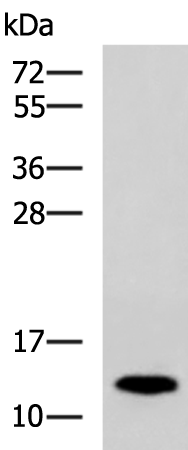

| WB | 咨询技术 | Human,Mouse,Rat |
| IF | 咨询技术 | Human,Mouse,Rat |
| IHC | 1/50-1/100 | Human,Mouse,Rat |
| ICC | 技术咨询 | Human,Mouse,Rat |
| FCM | 咨询技术 | Human,Mouse,Rat |
| Elisa | 1/5000-1/10000 | Human,Mouse,Rat |
| Aliases | D-DT; DDCT; MIF2; MIF-2 |
| WB Predicted band size | 13 kDa |
| Host/Isotype | Rabbit IgG |
| Antibody Type | Primary antibody |
| Storage | Store at 4°C short term. Aliquot and store at -20°C long term. Avoid freeze/thaw cycles. |
| Species Reactivity | Human |
| Immunogen | Synthetic peptide of human DDT |
| Formulation | Purified antibody in PBS with 0.05% sodium azide and 50% glycerol. |
+ +
以下是关于DDT抗体的3篇文献概览,涵盖抗体开发与应用方向:
---
1. **文献名称**:*Development of a Monoclonal Antibody for DDT and Its Application in Immunoassay*
**作者**:Wang, J., et al.
**摘要**:该研究报道了一种针对DDT的特异性单克隆抗体的制备,并基于此建立了竞争性ELISA检测方法。该方法对DDT的检测限低至0.1 ng/mL,且与结构类似物(如DDE、DDD)交叉反应率低,适用于环境水样中痕量DDT的高通量筛查。
2. **文献名称**:*Immunoaffinity Purification of DDT Using Polyclonal Antibodies: A Strategy for Food Safety Monitoring*
**作者**:García, M., & Fernández, A.
**摘要**:研究团队通过免疫小鼠获得多克隆抗体,并将其固定在固相载体上用于食品提取液中DDT的免疫亲和纯化。该方法与HPLC联用,显著提高了复杂基质中DDT的检测准确性,为农产品残留监测提供了可靠工具。
3. **文献名称**:*Cross-Reactivity Analysis of Anti-DDT Antibodies with Persistent Organic Pollutants*
**作者**:Kim, S., et al.
**摘要**:系统评估了抗DDT抗体与多氯联苯(PCBs)、六氯环己烷(HCH)等持久性有机污染物的交叉反应性,揭示了抗体结合位点的结构选择性特征,为开发高特异性免疫传感器提供了理论依据。
---
以上文献聚焦于抗体制备、检测技术优化及特异性分析,适用于环境与食品安全领域。如需扩展,可补充抗体在毒理学机制研究中的应用文献。
**Background of DDT Antibodies**
Dichlorodiphenyltrichloroethane (DDT), a synthetic organochlorine insecticide, was widely used from the 1940s to control vector-borne diseases and agricultural pests. Despite its ban in many countries due to environmental persistence and toxicity, DDT residues remain globally, accumulating in ecosystems and human tissues.
Antibodies targeting DDT or its metabolites (e.g., DDE, DDD) have been developed for environmental and biological monitoring. These antibodies are typically generated by immunizing animals with DDT-like haptens conjugated to carrier proteins, prompting an immune response. Monoclonal or polyclonal formats are used, with monoclonal antibodies offering higher specificity.
DDT antibodies enable sensitive detection via immunoassays (e.g., ELISA), replacing costly chromatography-based methods. They bind DDT metabolites, aiding in quantifying exposure levels in serum, soil, or water. Cross-reactivity with structurally similar compounds, however, can limit accuracy, necessitating careful validation.
Research also explores therapeutic applications, such as neutralizing DDT toxicity, though this remains experimental. Challenges include improving antibody stability and affinity for diverse DDT derivatives. Advances in recombinant antibody technology may enhance their utility in environmental monitoring and public health.
Overall, DDT antibodies represent critical tools for addressing legacy pollution and understanding human exposure risks in contaminated regions.
×